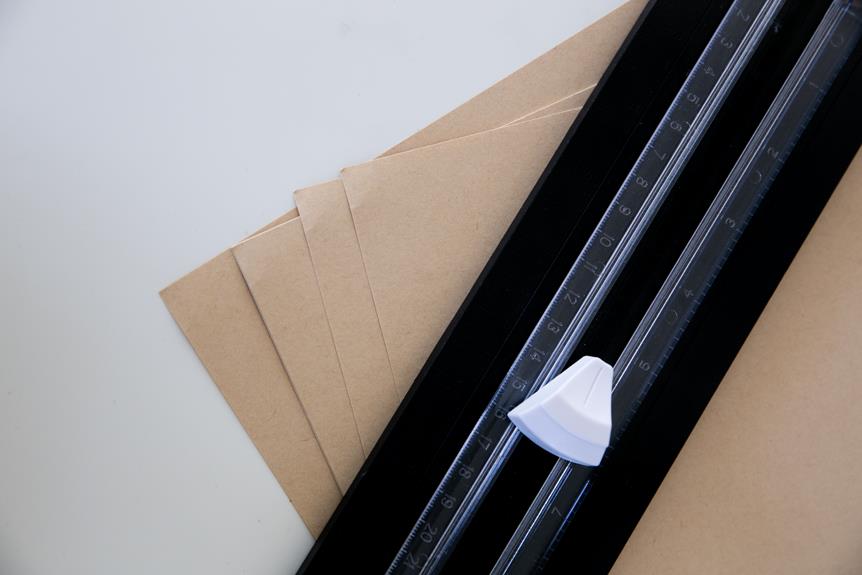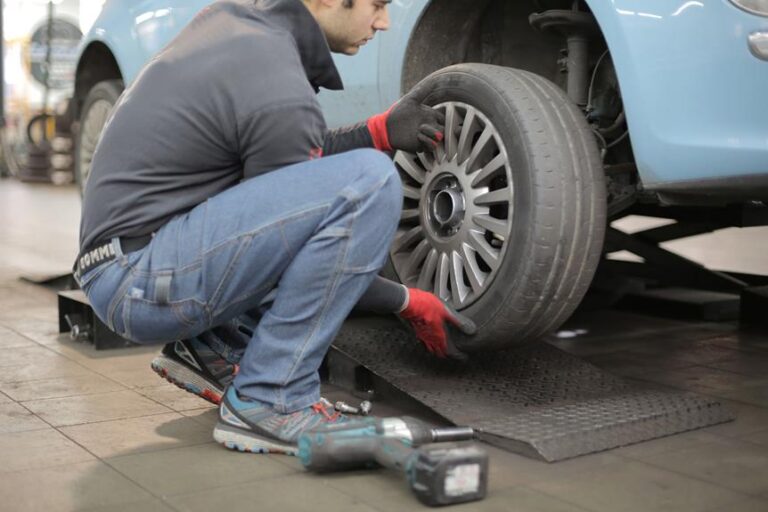A Guide to Tire Tread Depth Measurement
In the realm of automotive safety, the condition of one's tires can be likened to the compass guiding a ship through treacherous waters. A crucial aspect of tire maintenance is measuring the tread depth, as it directly affects a vehicle's grip on the road and overall safety.
This comprehensive guide aims to equip drivers with the necessary knowledge and tools to accurately measure tire tread depth, interpret the results, and ensure optimal safety on their journeys.
Key Takeaways
- Tire tread depth directly affects road grip and safety.
- Regular measurement of tread depth is crucial to identify when it falls below recommended levels.
- Accurate measurements help identify worn-out tires that need replacement.
- Tread wear patterns provide insights into tire condition and underlying issues.
The Importance of Tire Tread Depth
The accurate measurement of tire tread depth is crucial for ensuring optimal road grip and safety. Proper tire tread maintenance is essential to prevent accidents and maximize the performance of your vehicle. Tire tread depth refers to the measurement of the space between the top of the tread block and the bottom of the tire's grooves. This measurement directly impacts the tire's ability to grip the road, especially during braking.
When the tire tread depth is insufficient, the tire's ability to disperse water and maintain contact with the road surface is compromised. This can lead to a loss of traction, particularly in wet or slippery conditions, greatly increasing the risk of accidents. Additionally, tire tread depth directly affects braking performance. As the tread wears down, the tire's contact patch reduces, resulting in longer stopping distances and decreased braking efficiency.
Regularly measuring tire tread depth is crucial to identify when it falls below the recommended levels. The commonly used method involves using a tread depth gauge to measure the depth of the tire's grooves. It is important to measure tread depth at various points across the tire to ensure even wear.
Necessary Tools for Tire Tread Depth Measurement
To accurately measure tire tread depth, one must utilize a tread depth gauge, ensuring precise and reliable results. Tire tread depth gauges are essential tools used by automotive professionals and enthusiasts to determine the level of wear on their tires. These gauges are designed to provide accurate measurements, allowing users to determine if their tires meet safety standards and need replacement.
Tire tread depth gauges come in various types, including mechanical and digital. Mechanical gauges typically consist of a small metal rod or pin that is inserted into the tire groove. By pushing the gauge down until it reaches the bottom of the groove, the user can read the measurement displayed on the gauge. Digital gauges, on the other hand, use sensors to measure the depth of the tire tread and display the result digitally.
In addition to tread depth gauges, there are also tire tread depth indicators available. These indicators are small raised bars located within the tire groove, indicating the level of wear on the tire. The depth of the groove should ideally be above these indicators, ensuring adequate traction and grip on the road.
Overall, tire tread depth gauges and indicators are crucial tools in maintaining safe and reliable tires. By regularly measuring the tread depth, individuals can identify when their tires need replacement, preventing potential accidents and ensuring optimal performance on the road.
Step-by-Step Guide to Measuring Tire Tread Depth
When measuring tire tread depth, it is important to use a reliable and accurate tread depth gauge. This tool allows for precise measurement and assessment of the tire's condition. The recommended tools for measuring tread depth include digital tread depth gauges, mechanical tread depth gauges, and tread depth indicator cards.
To measure the tread depth, place the gauge into the groove of the tire and press it down until it makes contact with the base of the groove. The gauge will then display the measured depth in millimeters or inches. Repeat this process in several locations across the tire to ensure an accurate average measurement.
Common tread wear patterns can provide valuable insights into the condition of the tire and the vehicle's alignment. These patterns include center wear, shoulder wear, and cupping. Center wear indicates overinflation, while shoulder wear suggests underinflation or misalignment. Cupping, on the other hand, can be caused by suspension issues or improper tire rotation.
Regularly measuring tire tread depth is essential to maintain optimal performance and safety. By using a reliable tread depth gauge and understanding common tread wear patterns, drivers can identify potential issues early on and take necessary actions to ensure their tires are in good condition.
Understanding Tire Tread Wear Patterns
An understanding of tire tread wear patterns is crucial for maintaining tire performance and safety. Interpreting tread wear can provide valuable insights into the condition of your tires and help identify any underlying issues.
There are several common causes of uneven tread wear that can affect tire performance and longevity. These include:
- Improper inflation: Underinflated or overinflated tires can cause uneven wear patterns, such as cupping or shoulder wear.
- Misalignment: Incorrect wheel alignment can lead to irregular tread wear, often seen as feathering or diagonal wear.
- Suspension issues: Worn or damaged suspension components can cause uneven tire wear, such as excessive wear on one side or in the center.
- Improper tire rotation: Neglecting to rotate your tires regularly can result in uneven wear, with the front tires wearing differently than the rear tires.
- Driving habits: Aggressive driving, hard braking, and cornering can accelerate tread wear, especially on the edges of the tires.
By regularly inspecting and interpreting tread wear patterns, you can identify any issues early on and take appropriate action. This can include adjusting tire inflation, realigning the wheels, addressing suspension problems, or modifying driving habits.
Proper maintenance and addressing the common causes of uneven tread wear will help ensure optimal tire performance, safety, and longevity.
Interpreting the Results of Tire Tread Depth Measurement
By accurately measuring tire tread depth and carefully analyzing the results, you can determine the level of wear and make informed decisions regarding tire replacement or maintenance.
Tire tread depth measurement techniques play a crucial role in ensuring optimal performance and safety on the road. The most common method involves using a tread depth gauge, which is a simple tool that measures the depth of the tire grooves. It is important to measure the depth at multiple points across the tire and take an average to get an accurate reading.
Another technique involves using the 'penny test,' where you insert a penny into the tread grooves with Lincoln's head facing down. If you can see the top of Lincoln's head, it indicates that the tire tread is too worn and should be replaced.
When interpreting the results of tire tread depth measurements, it is essential to avoid common mistakes. One such mistake is failing to consider the legal tread depth requirements in your country or region. It is important to replace tires when they reach the minimum legal tread depth to ensure compliance with safety standards.
Additionally, it is crucial to consider other factors such as driving conditions and personal preferences when deciding whether to replace or maintain tires with certain tread depths.
Recommended Tread Depth for Different Types of Vehicles
The recommended tread depth for different types of vehicles depends on several factors, including the type of vehicle and the weather and road conditions it will be driven in.
For passenger vehicles, a minimum tread depth of 2/32 of an inch is recommended.
However, for commercial vehicles, especially those that operate in challenging weather and road conditions, a deeper tread depth of at least 4/32 of an inch is advised.
Regular checks of tire tread depth are essential to ensure optimal traction and safety on the road.
Passenger Vs. Commercial Vehicles
Passenger and commercial vehicles differ in their tread depth requirements, with the former typically needing a higher level of traction for smooth maneuvering on city roads. When considering passenger vs. commercial tire performance, it is important to take into account several factors affecting tire wear in different vehicles:
- Load capacity: Commercial vehicles usually carry heavier loads, which can cause more wear on the tires due to increased pressure and friction.
- Driving conditions: Commercial vehicles often operate in more challenging environments, such as construction sites or off-road terrains, which can accelerate tire wear.
- Driving style: Commercial drivers may have a more aggressive driving style, including frequent braking and acceleration, leading to faster tread wear.
- Tire construction: Commercial tires are often built with more durable materials and reinforced sidewalls to withstand the demands of heavy-duty use.
- Maintenance: Regular tire maintenance, including proper inflation and alignment, is crucial for both passenger and commercial vehicles to ensure optimal performance and longevity.
Understanding these factors will help vehicle owners make informed decisions when choosing tires and maintaining them for optimal performance and safety.
Weather and Road Conditions
When driving in inclement weather, it is crucial to have adequate tire tread depth and adjust your speed accordingly to ensure safe navigation through slippery road conditions.
Safe driving techniques in such conditions require an understanding of the impact of tire tread depth on braking distance. Tire tread depth plays a significant role in maintaining traction and preventing hydroplaning.
Hydroplaning occurs when a layer of water builds up between the tires and the road, causing loss of traction and control. Adequate tread depth helps to channel water away from the tire, providing better contact with the road surface. It also improves braking performance by reducing the braking distance.
As the tread depth decreases, the ability of the tire to grip the road surface diminishes, leading to longer braking distances. Therefore, it is essential to regularly check and maintain adequate tire tread depth for safe driving in inclement weather.
Importance of Regular Checks
Regularly checking and maintaining recommended tread depth is of utmost importance, as it ensures optimal traction and control on the road for different types of vehicles.
Here are some key points to consider when it comes to tire tread depth:
- Proper tread depth allows for better grip on wet or slippery surfaces, reducing the risk of hydroplaning.
- It improves braking performance, allowing for shorter stopping distances in emergency situations.
- Adequate tread depth enhances cornering stability and maneuverability, reducing the chances of skidding or losing control.
- Regular checks help identify uneven wear patterns, which may indicate the need for tire rotation. This process extends tire life by promoting even tread wear.
- Tire rotation also enhances fuel efficiency and maximizes tire performance.
By adhering to safe driving techniques and regularly checking and maintaining tire tread depth, drivers can ensure safer journeys, improved handling, and increased longevity of their tires.
Tips for Maintaining Optimal Tire Tread Depth
To maintain optimal tire tread depth, it is important to regularly check the condition of your tires and ensure they are properly inflated.
Additionally, practicing safe driving habits such as avoiding sudden stops and starts, reducing excessive speed, and avoiding aggressive cornering can help preserve the tread on your tires.
These tips will help prolong the life of your tires and ensure you maintain optimal traction and grip on the road.
Importance of Regular Checks
How frequently should one conduct tire tread depth measurements to ensure a safe driving experience? Regular tire tread depth measurements are crucial for maintaining safe driving techniques and reaping the benefits of proper tire maintenance. Here are five important considerations:
- Check tire tread depth at least once a month to monitor wear and tear.
- Use a tread depth gauge to accurately measure the depth of the tire grooves.
- Ensure that the tire tread depth is above the legal minimum requirement (usually 2/32 of an inch).
- Replace tires when the tread depth reaches 4/32 of an inch for optimal safety.
- Remember that proper tire maintenance, including keeping tires properly inflated and rotating them regularly, can extend their lifespan and improve overall driving performance.
Safe Driving Practices
Practicing safe driving practices includes maintaining optimal tire tread depth and regularly checking tire pressure. These safe driving habits are crucial for ensuring a smooth and secure driving experience. Tire maintenance plays a significant role in road safety, as it directly impacts vehicle handling and control.
Adequate tire tread depth is essential for proper traction on the road, especially in wet or slippery conditions. The recommended tread depth is at least 4/32 of an inch for safe driving.
Regularly checking tire pressure is equally important, as underinflated or overinflated tires can lead to reduced fuel efficiency, decreased handling capabilities, and increased risk of a blowout. It is advisable to check tire pressure at least once a month and adjust it according to the manufacturer's recommendations.
Signs of Worn-Out Tires and When to Replace Them
Inspecting the tread depth on a regular basis can help identify signs of worn-out tires and determine when they should be replaced. Tires are an essential component of any vehicle, and their condition directly impacts safety, performance, and fuel efficiency. Knowing when to replace tires is crucial to maintaining a safe and reliable vehicle.
Here are some key signs of tire aging and tips on how to extend tire lifespan:
- Tire Tread Depth: Measure the tread depth regularly using a tread depth gauge. If the depth is less than 2/32 of an inch, it's time to replace the tires.
- Uneven Tread Wear: Uneven wear patterns can indicate alignment or suspension issues. Regularly rotating the tires can help promote even wear.
- Cracks and Bulges: Check for sidewall cracks, bulges, or blisters. These can be signs of tire damage and potential tire failure.
- Excessive Vibration: Vibrations while driving can indicate tire imbalance or other tire-related issues. Get the tires inspected and balanced if needed.
- Age of the Tires: Even if the tread depth is sufficient, tires should be replaced after six years, regardless of mileage, due to the aging of rubber compounds.
To extend tire lifespan, follow these tips: maintain proper tire inflation, perform regular tire rotations, avoid overloading the vehicle, and drive responsibly by avoiding harsh acceleration, braking, and cornering. By taking these measures, you can ensure your tires stay in good condition, maximize their lifespan, and ensure your safety on the road.
Safety Benefits of Regularly Checking Tire Tread Depth
Regularly checking the tire tread depth can significantly enhance a vehicle's safety and the driver's peace of mind. Adequate tire tread depth is crucial in maintaining proper traction, especially in adverse weather conditions. When the tread depth is too low, the tires lose their ability to grip the road, increasing the risk of accidents.
One of the benefits of regularly checking tire tread depth is the ability to identify uneven wear patterns. Uneven tire wear can occur due to various factors such as improper tire inflation, misalignment, or lack of tire rotation. By detecting these issues early on, drivers can take necessary measures to rectify them, thereby avoiding further damage and increasing the lifespan of their tires.
Tire rotation is another important aspect of tire maintenance that can help prevent uneven tire wear. It involves moving the tires from one position to another on the vehicle to ensure even distribution of wear. This helps to maximize tire life and improve overall performance. By incorporating regular tire rotations into their maintenance routine, drivers can optimize the safety and longevity of their tires.
Frequently Asked Questions
How Often Should I Measure My Tire Tread Depth?
Tire tread depth should be checked regularly to ensure optimal safety and performance. A worn-out tread can significantly affect braking distance, making it crucial to measure tread depth periodically to maintain road grip and prevent accidents.
Can I Use a Penny or Quarter to Measure My Tire Tread Depth?
The use of a penny or quarter to measure tire tread depth is a common method, known as the penny test. However, there are alternative methods and tools available that provide more accurate and precise measurements.
What Are the Consequences of Driving With Low Tread Depth?
Driving with low tire tread depth can have serious consequences for safety and legal compliance. Reduced traction increases the risk of hydroplaning and loss of control, compromising the driver's freedom and posing a threat to their well-being and that of others on the road.
Are There Any Specific Tread Wear Patterns That Indicate Alignment Issues?
Wheel alignment problems can cause uneven tire wear, which can be identified by specific tread wear patterns. These patterns include feathering, camber wear, and toe wear. Regular inspection and maintenance can help detect and address alignment issues promptly.
Can Tire Tread Depth Affect My Vehicle's Fuel Efficiency?
The vehicle's fuel efficiency can be affected by tire tread depth. There is a correlation between tire tread depth and road grip, which can impact braking distance. Maintaining proper tread depth is crucial for optimal performance and safety.
Conclusion
In conclusion, measuring tire tread depth is crucial for vehicle safety and performance. By regularly checking and maintaining optimal tread depth, drivers can ensure better traction, handling, and braking capabilities.
This guide provides step-by-step instructions for measuring tread depth, understanding wear patterns, and interpreting the results. It also offers tips for maintaining optimal tread depth and recognizing signs of worn-out tires.
By following these guidelines, drivers can enhance their safety on the road and prolong the lifespan of their tires.







